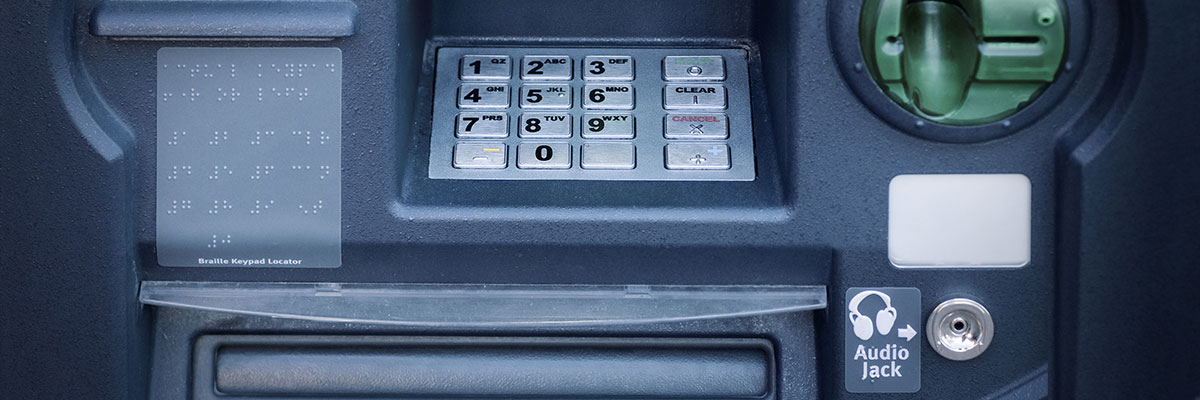In order to ensure appropriate accessible technology is used in the financial services sector, it is important that customers with disabilities know what’s
available to them. A 2015 report released by the National Disability Institute (NDI) found:
- Forty-six percent of households headed by an adult with a disability were unbanked or underbanked in 2013, compared to 29 percent of households headed
by an adult without a disability.¹ - Among households headed by a working-age person with a disability, nearly one-fifth were unbanked (18 percent) and more than one-fourth were underbanked
(28 percent).² - Households headed by a working-age person with a disability were significantly more likely to report using alternative financial services than households
headed by those without disability (47 percent vs. 35 percent, respectively).³
The data revealed in this report demonstrates that more needs to be done to increase awareness and use of available accessible technology (and services)
in the financial services sector. Customers with disabilities can only increase their knowledge base of economic and financial literacy by being given
the opportunity to develop their skills and receive coaching on accessing affordable accessible products and services that will lead to an increase in
participation in the industry.⁴ Many in the financial services sector feel that engaging people with disabilities is essential when developing products,
or when selecting technology for providing access to financial services; otherwise, the industry risks excluding a population that can be viable consumers
of financial products. Most importantly, the culture needs to be shifted to embrace and recognize that people with disabilities have the ability to positively
impact the economy and therefore, should have equal access to products and services that will allow them to achieve financial independence.⁵
Recognizing the important input that people with disabilities have to offer with regard to accessible technologies in the banking and financial services
sector is also something being considered in developing countries. For example, mobile-based financial products have had a great impact on lives of people
with disabilities. TchoTcho Mobile in Haiti, launched by Scotiabank together with DigiCel, and M-PESA in Kenya have created technology with the potential
to work using voice navigation, automated customer service and screen reader capability.⁶
Pina D’Intino, Senior Manager of Scotiabank reiterates the importance of getting input from people with disabilities regarding the use of accessible technologies
in the financial services sector. D’Intino states, “Access to financial services for persons with disabilities is no longer an area relegated to NGOs and
development institutions. It is a strategic growth area that banks and financial services organizations should tap into if they are to grow, retain market
share, and manage reputational risk.”⁷
In closing, while access to accessible financial and banking service options are improving in many countries, it’s important to understand that the creation
and access to these services for people with disabilities will further enhance an individual’s ability to participate in the market and achieve economic
growth. The increasing nature of services now available through technology has triggered growing demand among individuals with disabilities, who are continuously
left out of the banking and financial service industries.⁸
Original post can be found at: http://www.viscardicenter.org/resources/blog/accessible-tech-part-two.html
¹ Financial Knowledge Is Power for Americans with Disabilities (accessed April 29, 2016); available from
http://www.huffingtonpost.com/michael-morris/financial-knowledge-is-po_b_9729804.html
² Financial Knowledge Is Power for Americans with Disabilities (accessed April 29, 2016); available from
http://www.huffingtonpost.com/michael-morris/financial-knowledge-is-po_b_9729804.html
³ Financial Knowledge Is Power for Americans with Disabilities (accessed April 29, 2016); available from
http://www.huffingtonpost.com/michael-morris/financial-knowledge-is-po_b_9729804.html
⁴ Financial Knowledge Is Power for Americans with Disabilities (accessed April 29, 2016); available from
http://www.huffingtonpost.com/michael-morris/financial-knowledge-is-po_b_9729804.html
⁵ How Financial Services Providers Can Extend Disability Inclusion (accessed April 29, 2016); available from
https://cfi-blog.org/2014/02/06/how-financial-services-providers-can-extend-disability-inclusion/
⁶ How Financial Services Providers Can Extend Disability Inclusion (accessed April 29, 2016); available from
https://cfi-blog.org/2014/02/06/how-financial-services-providers-can-extend-disability-inclusion/
⁷How Financial Services Providers Can Extend Disability Inclusion (accessed April 29, 2016); available from
https://cfi-blog.org/2014/02/06/how-financial-services-providers-can-extend-disability-inclusion/
⁸ Is Banking Accessible to Persons with Disabilities? (accessed April 22, 2016); available from
https://www.linkedin.com/pulse/banking-accessible-persons-disabilities-nabil-eid
